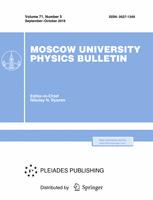Annotation
The procedure for constructing two-dimensional aperiodic constructive fractals and their classification are considered. The analysis of the experimental data indicates that the nanoparticle system in liquids, gases and on flat substrates can be characterized as spatially separated distribution of the particles and the presence of aggregate formation. Simulation of the nanoparticle distribution showed that even externally disordered nanoparticle systems without structural self-similarity can generate fractal diffraction patterns. The possibility to identify the various nanoparticle systems based on the definition of the scaling parameters as in diffraction patterns and within the objects is analyzed.
Received: 2015 February 14
Approved: 2015 March 18
PACS:
42.25.Fx Diffraction and scattering
42.30.Kq Fourier optics
61.43.Hv Fractals; macroscopic aggregates
61.46.-w Structure of nanoscale materials
42.30.Kq Fourier optics
61.43.Hv Fractals; macroscopic aggregates
61.46.-w Structure of nanoscale materials
© 2016 Publisher M.V.Lomonosov Moscow State University
Authors
M.V. Kovalchuk, P.V. Korolenko, Yu. V. Ryzhikova
Department of optics, spectroscopy and nanosystems physics, Faculty of Physics, Lomonosov Moscow State University. Moscow 119991, Russia.
Department of optics, spectroscopy and nanosystems physics, Faculty of Physics, Lomonosov Moscow State University. Moscow 119991, Russia.



